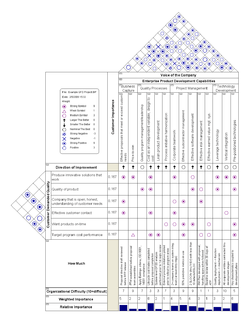House of quality

The house of quality, a part of QFD,[3] is the basic design tool of quality function deployment.[4] It identifies and classifies customer desires (WHATs), identifies the importance of those desires, identifies engineering characteristics which may be relevant to those desires (HOWs), correlates the two, allows for verification of those correlations, and then assigns objectives and priorities for the system requirements.[2] This process can be applied at any system composition level (e.g. system, subsystem, or component) in the design of a product, and can allow for assessment of different abstractions of a system.[2] It is intensely progressed through a number of hierarchical levels of WHATs and HOWs and analyse each stage of product growth (service enhancement), and production (service delivery).[5]
The house of quality appeared in 1972 in the design of an oil tanker by Mitsubishi Heavy Industries.[4]
The output of the house of quality is generally a matrix with customer desires on one dimension and correlated nonfunctional requirements on the other dimension.[2][6] The cells of matrix table are filled with the weights assigned to the stakeholder characteristics where those characteristics are affected by the system parameters across the top of the matrix.[6] At the bottom of the matrix, the column is summed, which allows for the system characteristics to be weighted according to the stakeholder characteristics.[6] System parameters not correlated to stakeholder characteristics may be unnecessary to the system design and are identified by empty matrix columns, while stakeholder characteristics (identified by empty rows) not correlated to system parameters indicate "characteristics not addressed by the design parameters".[6] System parameters and stakeholder characteristics with weak correlations potentially indicate missing information, while matrices with "too many correlations" indicate that the stakeholder needs may need to be refined.[6]